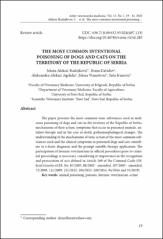| dc.contributor.author | Aleksić Radojković, Jelena | |
| dc.contributor.author | Davidov, Ivana | |
| dc.contributor.author | Aleksić Agelidis, Aleksandra | |
| dc.contributor.author | Vranešević, Jelena | |
| dc.contributor.author | Ivanović, Saša | |
| dc.date.accessioned | 2022-09-27T07:29:58Z | |
| dc.date.available | 2022-09-27T07:29:58Z | |
| dc.date.issued | 2022 | |
| dc.identifier.issn | 1820-9955 | |
| dc.identifier.uri | https://repo.niv.ns.ac.rs/xmlui/handle/123456789/552 | |
| dc.description.abstract | Th e paper presents the most common toxic substances used in malicious
poisoning of dogs and cats in the territory of the Republic of Serbia,
mechanisms of their action, symptoms that occur in poisoned animals, antidote
therapy and in the case of death, pathomorphological changes. Th e
understanding of the mechanisms of toxic action of the most common substances
used and the clinical symptoms in poisoned dogs and cats contribute
to a faster diagnosis and the prompt suitable therapy application. Th e
participation of forensic veterinarians in offi cial procedures prior to criminal
proceedings is necessary, considering its importance in the recognition
and prosecution of acts defi ned in Article 269 of the Criminal Code (Offi
cial Gazette of RS, No. 85/2005, 88/2005 - amended, 107/2005 - amended,
72/2009, 111/2009, 121/2012, 104/2013, 108/2014, 94/2016 and 35/2019). | en_US |
| dc.language.iso | en | en_US |
| dc.publisher | Scientific Veterinary Institute „Novi Sad“, Novi Sad, Serbia | en_US |
| dc.source | Arhiv veterinarske medicine / Archives of veterinary medicine | sr |
| dc.subject | animal poisoning | en_US |
| dc.subject | poisons | en_US |
| dc.subject | forensic veterinarian | en_US |
| dc.subject | crime | en_US |
| dc.title | The most common intentional poisoning of dogs and cats on the territory of the Republic of Serbia | en_US |
| dc.title.alternative | Najćešća namerna trovanja pasa i mačaka na teritoriji Republike Srbije | en_US |
| dc.type | Article | en_US |
| dc.doi | 10.46784/eavm.v15i1.283 | |
| dc.identifier.doi | 10.46784/eavm.v15i1.283 | |

